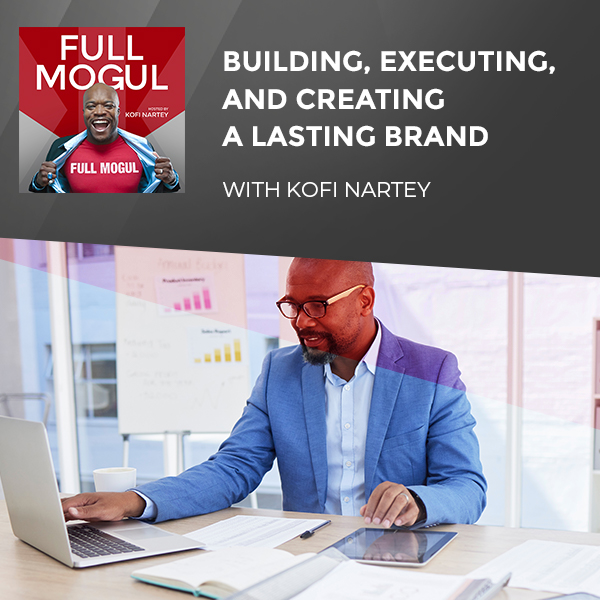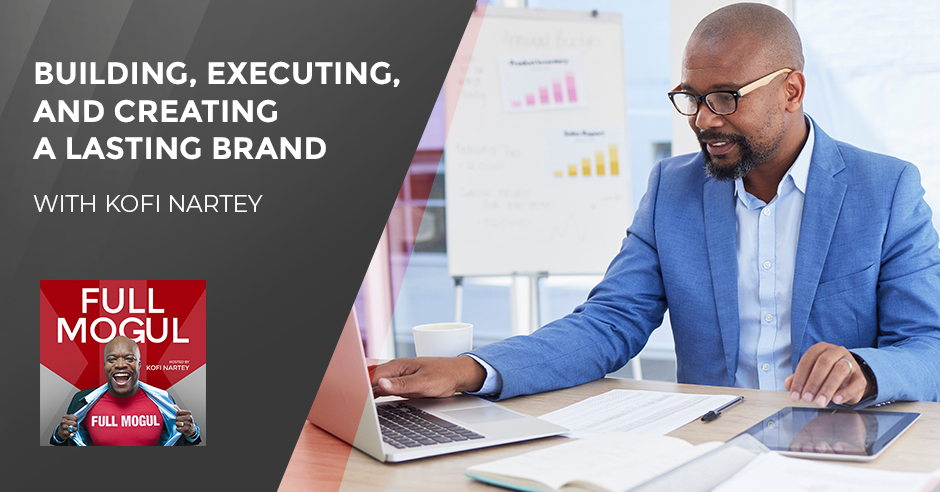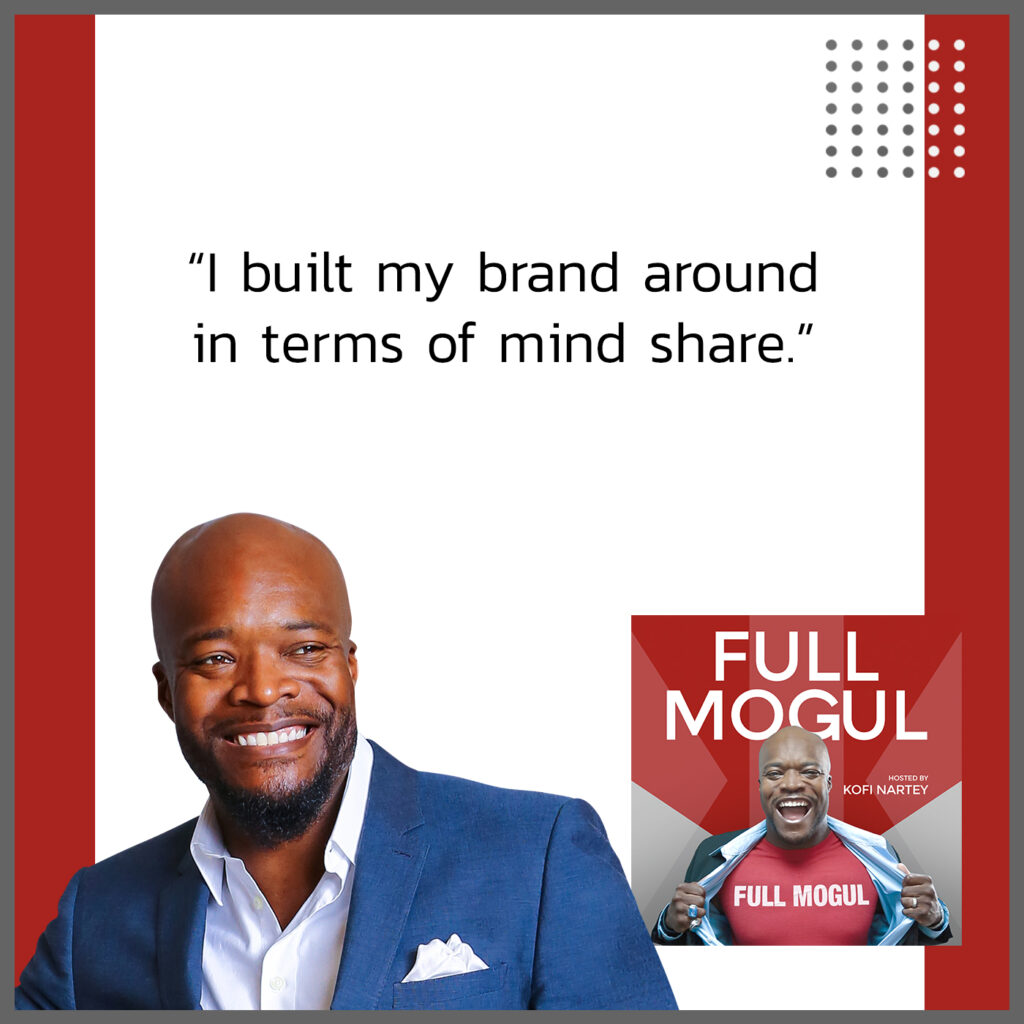

You are in for a treat today because Kofi Nartey is cooking a dish for you to make your brand last! Kofi provides tips for building, executing, and creating a lasting brand. Prepare a pen and paper because Kofi will share the key takeaways when you start to think about your brand. He also touches on the Marketing Five Cs and Mind Share. As Kofi mentioned, building your brand through storytelling will help reinforce your brand. So, don’t miss this episode and get a taste of Kofi Nartey’s insights on successfully building a lasting brand.
—
Listen to the podcast here
Building, Executing, And Creating A Lasting Brand With Kofi Nartey
I hope you folks are enjoying the journey we are pouring into this and, hopefully, pouring into you. The feedback has been great. The Mogul Nation community’s been great, and we’re going to rock and roll. I’m coming to you guys to talk about brand. The brand has become almost more important than ever. Creating a lasting brand takes structure, plan, and execution. I want to touch on those things. There are a lot of conversations that have been had about brands in the past. I’ve given a lot of talks on brand. I’ve had a lot of questions about brand, so I wanted to do a fast and furious episode with you folks about how to create a lasting brand.
I’m going to break it down into the three categories, building it, executing it, and making it last. First, let’s define brand. Brand, in a dictionary definition, is a name, term, design, symbol, logo, or any feature that identifies one seller’s product distinct from other sellers. When you think about brand, you think about the brands that you even engage with. When we think about executing a brand or creating a brand, if done properly, it will do a lot of the work for you because more so than often, more so than not, people are engaging with your brand before they engage with you.
People engage with your brand before they engage with you. Share on XBrand Is A Promise
I’m going to give you guys a lot of single-note takeaways. One of them is brand is a promise. It’s a promise of what the experience of working with you is going to be. This is how I have defined brand over the years, a promise of what the experience of working with you is going to be. That brand that shows up ahead of you is that glimpse into that.
We touched on a little bit about both personal brands and company brands. A lot of us who are sales people, especially in the real estate industry that I’m in. It’s a combination of the two. How are we marrying our own personal brand with the brand of the brokers that were a part of? Our value proposition is combined with the value proposition of the brand that we are a part of. First, let’s talk about building a brand.
When you are starting to think about brand, there are a few key things that you need to have as filters, as reference points, and as an outline for how you’re going to do it. The best way to do that is to ask yourself some key questions. Who are you servicing? What is the product or service that you’re bringing to whom you are servicing? How do you do it better than others?
You think about how you differentiate your product. What makes your product more unique? What makes it improved, better, or beyond other existing products that are out there? You can also think about is it a new product. Is this a new service that’s more innovative, better, unique, and something that’s going to change the game for a specific industry that you are bringing to the market?
I did a whole episode on SWOT analysis versus what I call OTSW because you have to change the letters around. Go back and check out that episode. I won’t spend a whole lot of time on SWOT analysis, but I’ll give you a high-level overview of what we talked about there. When you’re creating a brand, a SWOT analysis is a great approach to take.
SWOT stands for Strengths, Weaknesses, Opportunities, and Threats. Whenever you’re exploring a new business venture or, a new idea, or a new service, you can do a SWOT analysis. I’ve always thought that it should be reversed to what I call OTSW because when we look at going into a new market, a new field, or industry, if we start with our strengths but there’s no market for it, you’re destined for failure.
That’s why you have to reverse it. You have to look at the opportunities in the marketplace. Where is there a void? Where is there a problem that needs to be solved? You then hold up your strengths and say, “Here’s why and how I have the best strengths, the best products, or the best service to satisfy that opportunity, to fill that void and ease that pain in the market.”
Look at the opportunity first, and then we look at our strengths that we have to fill that void, to create a product or service, or to highlight the high-level aspects of your product or service that best service that need that fill that void. We think about a few things as it relates to that creation of the brand. I call them the five Cs. You folks may have heard about this in marketing.
The five Cs are Clean, Concise, Clear, Consistent, and Constant. You want your brand to be clean. It can’t be cluttered or messy. You want your messaging to be concise. You want it to be clear in terms of what the product is, what the service is, and who you are servicing. The constant piece is that you are putting your brand in front of people constantly. You are putting your brand in front of them on a regular basis. The consistency piece is that it’s consistent across the different platforms.

Lasting Brand: Put your brand in front of people constantly.
If somebody engages on your brand on social media, on your website, or in your printed materials, it’s consistent in the brand messaging, the logos, or the colors. I talked about SWOT analysis at the top. What we’ve transitioned to is what we call product market fit. Andresen came up with this concept of product market fit. How well is your product suited to fit a specific portion or part of the market? What we’re talking about here with that consistency and constancy is what we call time on brand. This is another term that we’re hearing more these days in marketing and in business. How much time are people spending on your brand?
Time On Brand Creates Mind Share
This is part of even as we get into the execution and making your brand last. You want to make sure people are spending time on brand because what time on brand does is it creates mindshare. I’m giving you guys a lot of these one-liners. Take notes. What is mindshare? Mindshare is when people think of a product or service, they think of you, or they think of your product or service. If I say hamburgers, what comes to mind? Maybe McDonald’s, even if you don’t eat them. Maybe In-and-Out, whatever it is, because those are very popular household brands.
When I say soda, you might think Coke or Pepsi because those are popular household brands. They have mindshare. When I say real estate, for my real estate professionals, are people thinking of you? When I say luxury and celebrity real estate, I’m hoping people think about it because that’s where I’ve built my brand around in terms of mindshare.

Here is a few more things to dig into as you’re building out your brand, a few more questions that you will be able to ask yourself to help build out those tenets of your brand. We won’t have time to go through the whole exercise, but I’m taking people through this in workshops and sessions to help them build out their brand in real time. Here’s one. How do you make people feel? If you can extract that, put it into your brand, and articulate that into your brand, your brand will start doing some of the work for you.
How do you benefit people by working with you? What’s the benefit to your product or service? Why should they work with you over other people who can provide a similar, if not the same, product or service? What words do others use to describe you? This is one of my favorite ones because if you don’t know, you should ask. Especially if you have a product or service that’s been in operations or has existed for a while, it’s a great exercise to reach out to some of your clients who will shoot straight with you or people who know you in your business and say, “What words come to mind when you think of me?” This is a great one.
The next one, what field or industry are you in or do you believe yourself to be in? This might seem pretty straightforward like, “I’m in real estate, sales, or marketing,” but we have to unpack that. I think about a lot of the platforms now, even the ecosystem and platform that my firm is a part of, the real broker. It’s a tech-based platform. In one aspect, they’re in real estate, but in another aspect, they’re a technology company. It is truly a technology company because of the innovation on the back end and the AI tools that we’re able to use. All the things that put our whole business in the palm of our hands on an app, that’s technology.
You’re in the technology business as well as the real estate business. You have to think, what industry are you in? What that does for you guys is it gives you a little bit of protection against blind spots. If you’re not innovating within technology if that’s part of your business, you can miss somebody who’s coming in to take you out of that business. When we think about Kodak in the film industry, then things went digital, and now you have your phones. We don’t even print photos anymore.
Technology took over something that was an actual hardbound product. Photos used to be printed out. You hold them in your hand, but now we keep everything in our phones. You have to think, what industry are you in? Sometimes it’s not even just the product, but you’re in a service industry. What is that service aspect of your product look like? Who’s your target audience? You have to know who your target audience is, specifically who your target audience is.
The more defined your target audience, the more specific and detailed that avatar of a client is, the better off you’re going to be in terms of reaching them and resonating with them. What do you do that makes you stand out from everybody else? We call this your USP or your Unique Selling Proposition. When you can articulate your unique value adds to your clients and what differentiates you from the competition, that’s where you win.
Usually, if you’re in an industry that’s somewhat saturated or oversaturated, you have to do these exercises to extract the unique adjectives and unique details that describe you over everyone else. If you do the exercise, there are things that you can say about yourself that nobody else can say. That’s when you start to win. When you identify those things, you can articulate those things and those things resonate with the clients that you’re pursuing. They resonate with the customers that you’re going after.
Not just things that you do, “I play the ukulele.” Whatever it is that you’re doing in your spare time, that’s fine, but what are those things that describe you in your service that will resonate with clients? Your attention to detail, your follow-up, or your specific expertise in that industry, those are the things that, in combination, you should be able to put together a narrative that other people cannot put together.
Let’s jump into some of the next things. You’ve built in your brand. You’re extracting all of these details and adjectives to describe your brand. How do you push it out there? How do you execute it and make it last? In the execution of your brand, this is where your materials come into play. This is where your website, designs, and logos come into play.
You have to create a memorable visual identity. The goal when you execute your brand that people will engage with often before they engage with you is when they’re walking down the street and they see your brand logo and your colors. In their peripheral vision, they start to recognize that as your brand. That’s when you know you’re doing a good job because it’s been clear, concise, and consistent and there’s constancy across all platforms. They’re constantly seeing it.
You have to create a memorable visual identity. Share on XAll of these things will help you develop something that’s not only memorable but maybe even visually appealing, especially if your brand has a story to it, being able to build that story into the narrative of your logos and brands. Our logo for Globl Red is for unlocking potential in people and in property. It’s open on one side to receive information, tools, and gifts. There’s a person or property in the middle, and then we open it up to share those gifts and that story with the world.
I love telling that story about our brand. The logo represents unlocking potential. You want to craft a very consistent message around your brand. Do you have 2 to 3 words that capture what you’re doing, dedicated, discreet, and driven? I had those as my mantra around what I was building for years. Do you have a very consistent message? This can tie into or be extracted from your mission statement or your value statement.
We’re not going to dive into that because we don’t have a lot of time. Spend a little time developing your mission, vision, and values. That will help you create your consistent messaging that you’re going to share with the world. You want to make sure that you’re building both a strong online presence and, if you are interfacing in a specific geographic area, a community presence. An online presence, so your website and social media. Are you leveraging social media? Are you leveraging the different social media platforms in the right way? Have you created a website that’s user-friendly and visually appealing, the user interface, something that is easy to navigate, people understand, and want to come back to that sticky? Meaning when they go to your website, is there information that keeps them there?
These are things you want to build into your online presence. Make sure you have a very good customer experience. This is another thing. When you have your brand and you get the opportunity to service somebody through your brand, make sure that the brand experience is built into the customer experience. When we talked about the messaging, is the messaging that you’re putting out there built into the customer experience? Part of what we talk about with Globl Real Estate and Development is we want to deliver inspirational excellence. We do what we do for real estate transactions in a way that is excellent, and that excellence is ideally inspiring to people. It makes them want to work with us. It makes them feel better after working with us, but are you delivering that throughout your customer experience?
You want to build in storytelling. Here’s another one, storytelling. What stories can you tell about your brand? What examples can you give through the form of stories that will help build and reinforce that brand identity? This is one of the keys to making your brand last because people will remember how they feel and remember the stories you tell them much more than they remember the self-promotion or brand promotion that you put out.
I always encourage our agents within our firm, and the agents within the real brokerage is then training with all of the agents. Build your value proposition into stories. It’s one thing to say, “I’m great because I do this.” It’s another thing to say, “I was able to help this client in this specific situation in this specific way to ultimately deliver on their desired outcome,” and give the example. Give the exact story. Tell those stories.
Adapt And Innovate
Next up, when it comes to making it last, you want to be able to adapt and innovate. I know we’re talking about building a brand, which means you shouldn’t be making changes to it right away, but if you’re getting consistent feedback, if you want to stay ahead of the curve and ahead of innovation, you have to be willing to adapt and innovate. The adoption and the innovation come from another strategic piece, which is measuring and analyzing the effectiveness of your brand, the outreach and the receptivity of the brand, how people are receiving your brand, the feedback you’re getting, and the social media engagement that you’re getting based on different posts and messaging.
Even that brand experience, getting feedback from the clients. This will help you in that innovation and know what to tweak, change, stay ahead of, be better at, and improve on instead of recreating the wheel. This is the mistake a lot of people make, even Alex Hormozi. Check out his show. I had a chance to meet him at the RISE real estate conference, and he talked about this.
He talks about this loop that entrepreneurs get stuck on, where things get difficult then they jump ship and do something else. Instead of constantly jumping ship, we need to look at our brands, products, and services and improve them because, by that point, you’ve done 80% or 90% of the work. That 10% that seems like it’s a failure, a challenge, or like, “This isn’t working,” is 10% that you need to focus on, fix, and fight through because you’ve done 90% of the work.
I hope this last thing I said hits home because a lot of us entrepreneurs are guilty of this. It’s that Shiny Object syndrome. We pick up a shiny object. We love it, hold it, and squeeze it until it’s slightly dull, then we look for another shiny object, but just know that if you haven’t heard it before or haven’t heard in this way, that shiny object, when you pick it up, engage with, and go on this journey with it, it’s going to get dull before it gets shiny again.
There’s a diamond in the middle of it, but that shiny part that attracted your attention is going to turn into coal. That coal is going to be squeezed down into that diamond that’s in the middle. You have to stay true to the journey. You have to stay in the course. In terms of your clients, we want to make sure that we’re investing in a long-term brand relationship with our clients. You want to prioritize building relationships with your clients.
When you have that brand, service, or product, that experience is going to start the relationship, and how the relationship starts is usually how it will continue. What are the aspects of your brand that are infused into that relationship and that experience? What are the keys or strategies to maintaining an ongoing relationship with your clients? It’s much easier to retain clients and get referrals from those clients than it is usually to acquire new clients.
You want to build those relationships, and you want to have community engagement with this database of people, consumer, and client base that you’ve built. You want to stay engaged with them for the long run. What does that look like? How do you do it? How does your brand test them? Do you have a newsletter? Do you have a get-together? Do you send out holiday cards? Do you text them or reach out to them quarterly or monthly? What is that look like? What’s that cadence?
Make sure that you keep those relationships and not just a sales relationship but a human relationship, which brings me to my last major point on how to build a brand that lasts. That’s to evolve with purpose. If you don’t have an underlying driver or purpose for what you’re doing, you may get burnt out faster. You might lose that vision faster, and you may fizzle out because this is not something that you’re truly passionate about.
If you can continue to evolve with purpose, why does it matter that you’re doing what you’re doing? Why is it important to you that people are working with you over other people? I always tell people I don’t mind pushing for people to work with us because I know that they’re going to be in better hands with us than they are with somebody else. If you care about people, you want what’s best for them.
If you feel like your product or service is best for them, then you will push them to work with you because you know you’re going to protect them better, service them better, and their ultimate outcome is going to be better. Take these notes as you’re building out your brand. I know there’s a lot more we can dive into, but I’ve given you a lot here in this quick jam session. Make sure that you spend the time upfront to build the infrastructure for it, capture the essence of the brand, to then execute it, and build it into the client experience.
If you don’t put the infrastructure together, your brand will still develop, but it won’t develop with your input or feedback. It won’t. You have to make sure that you spend the time upfront to work on it to make sure that it has the infrastructure not only for scale but also for longevity. I talked about being passionate and even evolving with purpose. It doesn’t have to be your lifelong passion to build a brand that’s amazing that you can execute on, but it does have to be something that you can get up in the morning and feel driven to do for the next 5 years, 10 years, or maybe even 15 years before you do something new.
I’m an entrepreneur. I get it. When you’ve gotten to that point where you feel like you’ve maximized something that you’ve built or worked on, it’s either time to iterate, grow, or do something else. Sometimes, we feel that way too soon or too early, which is not staying on your full mogul journey. It’s jumping from a new journey to a new journey, and that’s not what we want to do. We want to see things through. We want to focus and finish.
If this was helpful, you folks can find me on social media @Kofi_Sellebrity. You can visit FullMogul.com, listen to other podcasts, or on Spotify and Apple. Share this with somebody. Let’s take some time to work on those brands. If you already have a great brand, use some of those questions to improve your brand. Join us if you’re not already with us. If you already are, stay with us on this full mogul journey.
Important Links
- SWOT vs. OTSW – Previous Episode
- @Kofi_Sellebrity – Instagram
- @Kofi_Sellebrity – TikTok
- Apple Podcasts – Full Mogul Podcast
BACK TO BLOG